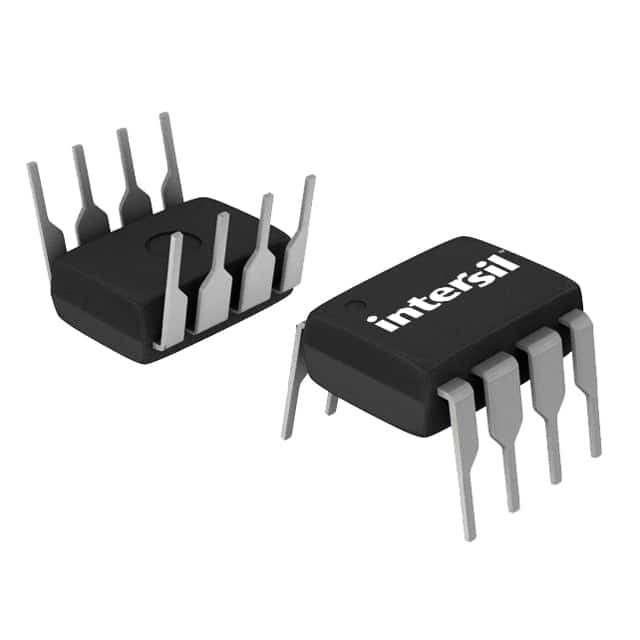Viz Specifikace pro podrobnosti o produktu.

X5045PI-2.7
Product Overview
Category: Integrated Circuit (IC)
Use: Non-volatile Electrically Erasable Programmable Read-Only Memory (EEPROM)
Characteristics: - Low power consumption - High reliability - Wide operating voltage range - Small package size - Easy to integrate into electronic systems
Package: DIP-8 (Dual In-line Package with 8 pins)
Essence: X5045PI-2.7 is a high-performance EEPROM IC designed for non-volatile data storage in various electronic devices.
Packaging/Quantity: The X5045PI-2.7 is typically packaged in reels or tubes, with a quantity of 2500 units per reel/tube.
Specifications
- Supply Voltage Range: 2.7V to 5.5V
- Operating Temperature Range: -40°C to +85°C
- Memory Capacity: 4 kilobits (512 bytes)
- Interface: Serial Peripheral Interface (SPI)
- Write Endurance: 1 million cycles
- Data Retention: 100 years
Detailed Pin Configuration
The X5045PI-2.7 has the following pin configuration:
| Pin No. | Name | Function | |---------|------|----------| | 1 | CS | Chip Select (active low) | | 2 | SCK | Serial Clock | | 3 | SI | Serial Data Input | | 4 | SO | Serial Data Output | | 5 | WP | Write Protect (active low) | | 6 | VSS | Ground | | 7 | NC | No Connection | | 8 | VCC | Power Supply |
Functional Features
- Byte-level read and write operations
- Software and hardware write protection
- Sequential read mode for faster data retrieval
- Built-in voltage detection and reset circuitry
- Low standby current for power-sensitive applications
Advantages and Disadvantages
Advantages: - High reliability due to non-volatile memory technology - Wide operating voltage range allows compatibility with various systems - Small package size enables space-saving designs - Easy integration into electronic systems due to the SPI interface
Disadvantages: - Limited memory capacity (4 kilobits) - Relatively slower write speed compared to other memory technologies
Working Principles
The X5045PI-2.7 utilizes EEPROM technology, which allows for non-volatile data storage. It uses a Serial Peripheral Interface (SPI) for communication with the host system. The chip select (CS), serial clock (SCK), and serial data input/output (SI/SO) pins are used to control data transfer between the IC and the host.
When writing data, the write protect (WP) pin can be used to enable or disable write operations. The X5045PI-2.7 also features built-in voltage detection and reset circuitry to ensure reliable operation.
Detailed Application Field Plans
The X5045PI-2.7 is widely used in various electronic devices that require non-volatile memory storage. Some common application fields include:
Consumer Electronics:
- Smartphones
- Tablets
- Digital cameras
- Portable media players
Automotive:
- Engine control units
- Infotainment systems
- Dashboard displays
Industrial Automation:
- Programmable logic controllers (PLCs)
- Human-machine interfaces (HMIs)
- Data loggers
Medical Devices:
- Patient monitoring systems
- Medical imaging equipment
- Laboratory instruments
Detailed and Complete Alternative Models
- X5045PI-2.5: Similar to X5045PI-2.7, but operates at a supply voltage range of 2.5V to 5.5V.
- X5045PI-3.3: Similar to X5045PI-2.7, but operates at a supply voltage range of 3.3V to 5.5V.
- X5045PI-5.0: Similar to X5045PI-2.7, but operates at a supply voltage range of 5.0V to 5.5V.
These alternative models provide flexibility in choosing the appropriate operating voltage for specific system requirements.
In conclusion, the X5045PI-2.7 is a high-performance EEPROM IC that offers reliable non-volatile data storage in various electronic devices. Its low power consumption, small package size, and wide operating voltage range make it suitable for a wide range of applications. However, its limited memory capacity and relatively slower write speed should be considered when selecting an alternative model.
Seznam 10 běžných otázek a odpovědí souvisejících s aplikací X5045PI-2.7 v technických řešeních
Sure! Here are 10 common questions and answers related to the application of X5045PI-2.7 in technical solutions:
Q: What is the X5045PI-2.7? A: The X5045PI-2.7 is a specific model of integrated circuit (IC) used for non-volatile memory storage.
Q: What are the typical applications of X5045PI-2.7? A: X5045PI-2.7 is commonly used in various technical solutions such as embedded systems, industrial automation, consumer electronics, and automotive applications.
Q: What is the storage capacity of X5045PI-2.7? A: The X5045PI-2.7 has a storage capacity of 4 kilobits (Kb), which is equivalent to 512 bytes.
Q: How does X5045PI-2.7 communicate with other components in a system? A: X5045PI-2.7 typically uses a standard serial interface such as SPI (Serial Peripheral Interface) or I2C (Inter-Integrated Circuit) to communicate with other components.
Q: Can X5045PI-2.7 be used for data logging purposes? A: Yes, X5045PI-2.7 can be used for data logging as it provides non-volatile storage, allowing data to be retained even when power is removed.
Q: Is X5045PI-2.7 suitable for low-power applications? A: Yes, X5045PI-2.7 is designed to operate at low power, making it suitable for battery-powered or energy-efficient devices.
Q: Does X5045PI-2.7 support hardware write protection? A: Yes, X5045PI-2.7 has built-in hardware write protection features that can be used to prevent accidental or unauthorized modification of stored data.
Q: Can X5045PI-2.7 withstand harsh environmental conditions? A: X5045PI-2.7 is designed to operate reliably in a wide range of temperatures and can withstand moderate levels of shock and vibration.
Q: Are there any limitations to the number of read/write cycles for X5045PI-2.7? A: X5045PI-2.7 has a specified endurance rating, typically allowing for a minimum of 1 million read/write cycles.
Q: Is X5045PI-2.7 compatible with other memory devices? A: X5045PI-2.7 can be easily integrated into systems that use other memory devices such as microcontrollers, EEPROMs, or flash memory.
Please note that the specific details and features may vary depending on the manufacturer's specifications and application requirements.

